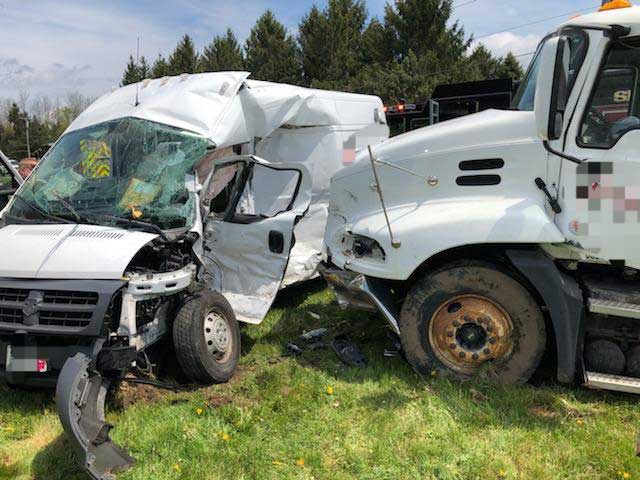
By Jake Bromage and Bill Hallinan
The influence of the global COVID-19 pandemic and increase in e-commerce can be seen on the roadways. Online commerce increased 30.1 percent in the first two quarters of 2020 1.Prior to the pandemic, 2019 full-size van sales were growing: Ford Transit sales grew 11.7 percent, Ram ProMaster grew 21 percent, and Mercedes-Benz Sprinter sales grew 9.1 percent. These trends seem to continue, as Amazon intends add 10,000 electric vans to the road by 2022. These units built by Rivian include safety driver assist systems and a reinforced driver door. 2 Incidents involving small commercial delivery vehicles will likely also increase proportionally. These vehicles have some unique characteristics that rescue teams may need to consider and adjust for.
The modern full-size delivery van comes in at a weight of 3,500-4,500 pounds and has a payload capacity of an additional 2,400-4000 pounds. Traditional prediction of crash expectations are difficult as it appears neither the National Highway Traffic Safety Administration (NHTSA) or the Insurance Institute for Highway Safety (IIHS) have complete and comparable data sets and ratings yet for these vehicles. Because of this, most of the information related to rescue for these vehicles is anecdotal and from single department experiences. We will attempt to grow this data sharing our experience with a heavy impact rescue with a delivery van.

Case Study
Early in 2020, we were dispatched to a motor vehicle collision involving a delivery van and a loaded dump truck with a person trapped. A driver’s side impact of the delivery van left the driver trapped with an angulated leg injury and impact-side facial injuries. There were several unique challenges since the likely rescue path was obstructed by the dump truck, which rested against the driver’s door. This was addressed by pulling the two vehicles apart with a winch. The van style itself presented some unique challenges and opportunities. The rescue was successful accomplished with a conventional door removal, interior debris removal, and cutting of the seat and the seatback. The patient was removed in 22 minutes, transferred to a trauma center, and has recovered.

Lessons Learned
In applying the rescue process to these vehicles, some items stand out that responders should consider.
Initial safety concerns should always include the cargo inside. Although small in quantity for residential delivery, it’s possible that goods that can interact and contribute to fire growth or be hazardous to responders. Stabilization of these vehicles may appear challenging but they have some beneficial characteristics. Despite being tall, they have a low ground clearance, so simple step chocks or cribbing can initially be very effective. They often have a “ladder frame” chassis with multiple ridged structures under the body. The walls are reinforced at about four- to six-foot intervals so side wall strong points are relatively easy to locate. However, unsecure loads may shift internally and be unnoticed by responders, so off-center vehicles should be stabilized with secondary stabilization when needed. Occupant access may be challenging because of the lack of windows. In severe-impact frontal collisions, entry from the side by cutting the body structure or rear doors may be the only way into the patient compartment.
RELATED FIREFIGHTER TRAINING
Auto Extrication: When Hydraulics Go Down
Extrication: The No Relief Cut-Dash Lift
Big Truck Extrication: A Different Animal
The front compartment often will have all the modern safety features of a car because they fall into the 10,000 pound or less gross vehicle weight rating. Airbags may be found in the sidewalls or seat structure. The engine is often lower than most small cars and, depending on the opposing vehicle sizes, may create more intrusion into the lower leg compartment.
There are some design features that may require rescue teams to modify their standard rescue playbook techniques. Side sliding doors offer large access spaces and crews should be able to cut or disengage the sliding mechanism in all three points of contact. The unique construction of the lower A post to the wheel well offers little space to position spreaders for vertical lifting. The front fender and panel are forward proportionate to the engine and dash, making conventional relief cuts to push the dash forward possibly less effective. If moving a dash forward is a challenge, the raised seat position lends itself to being cuttable and the seat removed from under the occupant to extricate the patient to the rear of the vehicle. In some models, however, there is a wall between the driver and cargo space that needs to be removed. An alternative maneuver is to remove the side wall behind the driver’s seat to allow the access created in a total side wall removal of a car.
These vehicles will likely continue to be more prevalent and require some modifications to rescue maneuvers but can easily be defeated with a well-resourced coordinated rescue team in a timely manner.
REFERENCES
1. Fareeha Ali. Digital Commerce 360. Aug 25, 2020. Charts: How the coronavirus is changing ecommerce. https://www.digitalcommerce360.com/2020/08/25/ecommerce-during-coronavirus-pandemic-in-charts/
2. Hawkins, A. The Verge.com. October 8, 2020. https://www.theverge.com/2020/10/8/21507495/amazon-electric-delivery-van-rivian-date-specs
Jake Bromage is a captain with the Spencerport (NY) Fire District.
Bill Hallinan is assistant chief with the Spencerport (NY) Fire District.

